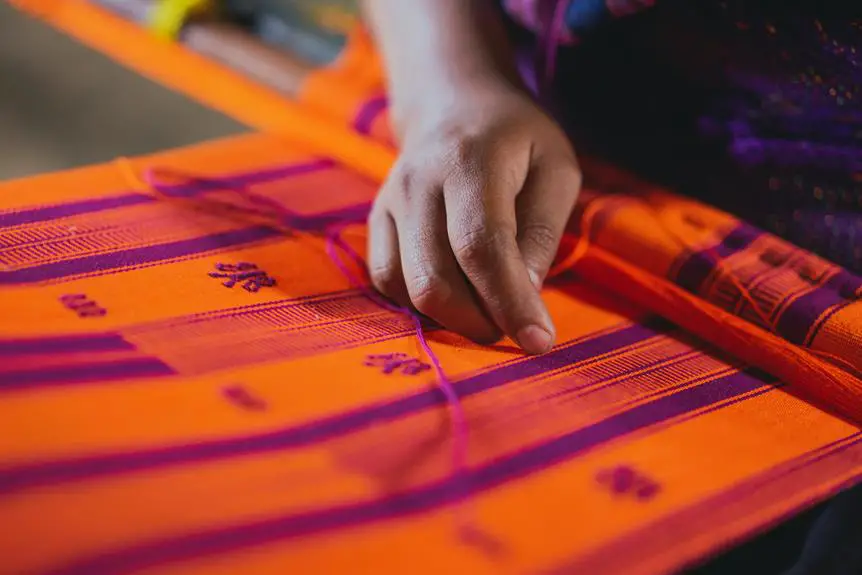When you're looking to acid wash fabrics effectively, it's crucial to grasp the underlying techniques for achieving that perfect faded look. You'll need to prepare your workspace and gather the right materials to ensure a safe and successful process. By applying a diluted hydrochloric acid solution strategically, you can create stunning effects on cotton or denim. However, it's not just about the application; understanding timing and rinsing methods can make all the difference. Curious about the specific steps and safety precautions? Let's explore the best practices that can elevate your fabric projects.
Table of Contents
Key Takeaways
- Choose cotton or denim fabrics for optimal acid washing results, as they respond best to the acid solution.
- Pre-wash the fabric to eliminate any finishes or dirt that may hinder the acid's effectiveness.
- Dilute hydrochloric acid carefully and use a spray bottle for controlled application on the fabric.
- Monitor exposure time to achieve the desired lightness or darkness, rinsing thoroughly after 10-15 minutes.
Understanding Acid Washing
Acid washing is a technique that creates a unique, distressed look on fabrics by using a mild acid solution to selectively lighten colors and enhance texture. When you decide to acid wash, you're essentially transforming the fabric's appearance, giving it an edgy, vintage vibe. This process works best on cotton or denim, as these materials respond well to the acid's effects.
As you dive into acid washing, it's important to understand the science behind it. The mild acid reacts with the dye in the fabric, breaking it down and allowing you to achieve varying shades of color. You can create patterns or even a gradient effect, depending on how you apply the solution. By controlling the exposure time, you can determine how light or dark the final product will be.
Additionally, acid washing isn't just about aesthetics; it can also improve the texture of the fabric. You'll notice that the fibers become softer and more pliable, enhancing the overall feel.
Materials Needed for Acid Washing
To get started with acid washing fabrics, you'll need a few essential materials to ensure a successful transformation.
First, gather your fabric items—denim or cotton works best for this technique. Next, you'll need a bucket or a large container for mixing your acid solution.
Hydrochloric acid is the most commonly used acid for this process, so make sure to purchase it from a reputable source. Remember to wear safety goggles and gloves to protect yourself while handling the acid.
You'll also need water to dilute the acid, as well as a measuring cup for accurate proportions.
In addition to your acid solution, consider having a spray bottle handy. This can help you control the application and achieve desired patterns on your fabric. Old rags or sponges can also be useful for applying the acid.
Step-by-Step Acid Washing Process
Start by preparing your workspace and gathering all your materials to ensure a smooth acid washing process. You'll need your fabric, acid solution, gloves, and a spray bottle. Make sure you choose a well-ventilated area to work in, as the fumes can be strong.
Next, protect your workspace by covering surfaces with plastic sheeting or newspapers. Put on your gloves to keep your hands safe from the acid. Dilute your acid solution according to the instructions and fill your spray bottle.
Now, it's time to apply the acid. Lightly spray the fabric, focusing on areas where you want a faded look. Remember, less is more. You can always add more acid, but you can't take it back once it's applied.
After spraying, let the fabric sit for about 10-15 minutes, then rinse thoroughly with water to stop the acid's action. Finally, wash your fabric in the laundry to remove any remaining chemicals.
Here's a quick reference table for your acid washing process:
| Step | Action | Time |
|---|---|---|
| Prepare Workspace | Gather materials | 10 minutes |
| Apply Acid | Spray fabric | 5 minutes |
| Let it Sit | Allow acid to work | 10-15 minutes |
| Rinse and Wash | Clean fabric thoroughly | 15 minutes |
Tips for Successful Acid Washing
Ensuring the right conditions and techniques can significantly enhance the outcome of your acid washing project.
First, select the appropriate fabric; cotton and denim respond best to acid washing. Before you start, pre-wash the material to eliminate any finishes or dirt that might interfere with the acid's effectiveness.
Next, prepare your workspace. A well-ventilated area with a flat surface will help you manage the process more efficiently. Wear protective gloves and eyewear to shield yourself from any splashes.
When mixing your acid solution, follow the recommended ratios carefully to avoid overly aggressive reactions.
As you apply the acid, work in sections. This allows you to control the fading and achieve a more uniform look.
Don't rush the process; let the acid sit for the recommended time to maximize results.
Rinse thoroughly after the desired effect is achieved to neutralize the acid.
Safety Precautions to Consider
Always prioritize safety by wearing appropriate protective gear, including gloves, goggles, and a mask, when working with acid solutions. These measures help shield you from harmful splashes and fumes. Make sure you're working in a well-ventilated area, preferably outdoors, to minimize inhalation risks.
Before you start, familiarize yourself with the Material Safety Data Sheet (MSDS) for the acids you're using. It provides essential information about hazards, handling, and first-aid measures. Additionally, keep a neutralizing agent, such as baking soda, on hand in case of spills.
Here's a quick reference table for safety precautions:
| Safety Gear | Purpose | Action |
|---|---|---|
| Gloves | Protect hands from chemicals | Always wear thick, chemical-resistant gloves |
| Goggles | Shield eyes from splashes | Ensure goggles fit securely and cover all areas |
| Mask | Prevent inhalation of fumes | Use a mask rated for chemical vapors |
| Ventilation | Reduce inhalation risks | Work outdoors or in a well-ventilated space |
Frequently Asked Questions
Can I Acid Wash Colored Fabrics Without Fading Them?
You can't completely avoid fading when acid washing colored fabrics. However, using a diluted solution and testing on a small area first may help minimize color loss while achieving the desired distressed look you want.
What Types of Fabrics Are Unsuitable for Acid Washing?
You shouldn't acid wash delicate fabrics like silk or lace, as they can't withstand harsh chemicals. Additionally, synthetic materials like polyester may not react well, leading to uneven results or damage. Always check fabric labels first.
How Do I Store Acid-Washed Fabrics Properly?
To store acid-washed fabrics properly, fold them neatly and place them in a cool, dry area. Avoid direct sunlight and damp environments to prevent fading or mildew, ensuring they stay fresh and vibrant for future use.
Can I Acid Wash Fabrics at Home Without Professional Help?
Yes, you can acid wash fabrics at home without professional help. Just gather your materials, follow a simple process, and ensure you're in a well-ventilated area. It's fun and gives your fabrics a unique look!
What Are the Environmental Impacts of Acid Washing Fabrics?
Acid washing fabrics can harm the environment by releasing harmful chemicals into water systems. You're contributing to pollution and potential health risks for aquatic life, so consider eco-friendly alternatives that minimize your impact on nature.
- How Does Ring Spun Cotton Affect Garment Fit and Shape Retention? - August 13, 2024
- What Are the Challenges in Producing Ring Spun Cotton? - August 13, 2024
- Is Ring Spun Cotton Suitable for Plus-Size Clothing? - August 13, 2024







